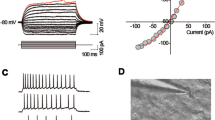Summary
Brain cortex slices were preincubated with 3H-noradrenaline and superfused with physiological salt solution containing desipramine. We studied the inhibition of the electrically evoked tritium overflow caused by histamine in the presence of α-adrenoceptor ligands (mouse and rat brain cortex), and the inhibition caused by talipexole (the former B-HT 920) in the presence of H3-receptor ligands (mouse brain cortex).
In mouse brain cortex slices, the inhibitory effect of histamine on the tritium overflow evoked by 36 pulses, 0.3 Hz was not changed by the α1-adrenoceptor antagonist prazosin, but increased by the α2-adrenoceptor antagonist rauwolscine. When the current strength or the duration of electrical pulses was reduced to compensate for the increase in evoked tritium overflow produced by rauwolscine, the latter still. enhanced the effect of histamine. The histamine-induced inhibition of tritium overflow evoked by 360 pulses, 3 Hz was not affected by the α1-adrenoceptor agonist phenylephrine but attenuated by the α2-adrenoceptor- agonist talipexole. Finally, the inhibition by histamine of the tritium overflow evoked by 3 pulses, 100 Hz was attenuated by talipexole but not affected by rauwolscine. Conversely,. the inhibitory effect of talipexole on tritium overflow elicited by 360 pulses, 3 Hz was slightly attenuated by the H3-receptor agonist R-(−)-α-methylhistamine but not, affected by the H3- receptor antagonist thioperamide. In rat brain cortex slices, histamine only tended to inhibit tritium overflow evoked by 360 pulses, 3 Hz, both in the absence of α-adrenoceptor antagonists and in the presence of prazosin. However, histamine markedly inhibited the evoked overflow in the presence of rauwolscine. Again, enhancement of the histamine-induced inhibition also occurred when the current strength or the duration of pulses was reduced in order to compensate for the increase in evoked tritium overflow produced by rauwolscine.
The results suggest that the α2-autoreceptors and the H3-heteroreceptors at the noradrenergic nerve endings in the brain of mouse and rat interact with each other. Activation of the α2-autoreceptors decreases, whereas blockade of the activated (but not of the non-activated) α2-autoreceptors increases, the inhibitory effect of histamine. Activation of the H3-heteroreceptors slightly decreases, whereas blockade of the H3-receptors fails to affect, the inhibitory effect of talipexole.
Similar content being viewed by others
References
Allgaier C, Hertting G, von Kügelgen O (1987) The adenosine receptor-mediated inhibition of noradrenaline release possibly involves a N-protein and is increased by α2-autoreceptor blockade. Br J Pharmacol 90:403–412
Limberger N, Späth L, Hölting T, Starke K (1986) Mutual interaction between presynaptic α2-adrenoceptors and opioid κ-receptors at the noradrenergic axons of rabbit brain cortex. Naunyn-Schmiedeberg's Arch Pharmacol 334:166–171
Limberger N, Singer EA, Starke K (1988) Only activated but not non-activated presynaptic α2-autoreceptors interfere with neighbouring presynaptic receptor mechanisms. Naunyn-Schmiedeberg's Arch Pharmacol 338:62–67
Lümmen, G, Schlicker E (1991) Presynaptic histamine H3 receptors on the noradrenergic neurones in the rat brain: investigations into signal transduction and interaction with α2-autoreceptors. Naunyn-Schmiedeberg's Arch Pharmacol 343 [Suppl]:R94
Molderings GJ, Göthert M (1990) Mutual interaction between presynaptic α2-adrenoceptors and 5-HT1B receptors on the sympathetic nerve terminals of the rat inferior vena cava. Naunyn-Schmiedeberg's Arch Pharmacol 341:391–397
Ramme D, Illes P, Späth L, Starke K (1986) Blockade of α2-adrenoceptors permits the operation of otherwise silent opioid κ-receptors at the sympathetic axons of rabbit jejunal arteries. Naunyn-Schmiedeberg's Arch Pharmacol 334:48–55
Schlicker E, Fink K, Hinterthaner M, Göthert M (1989) Inhibition of noradrenaline release in the rat brain cortex via presynaptic H3 receptors. Naunyn-Schmiedeberg's Arch Pharmacol 340: 633–638
Schlicker E, Schunack W, Göthert M (1990) Histamine H3 receptor-mediated inhibition of noradrenaline release in pig retina discs. Naunyn-Schmiedeberg's Arch Pharmacol 342:497–501
Schlicker E, Glaser T, Lümmen G, Neise A, Göthert M (1991) Serotonin and histamine receptor-mediated inhibition of serotonin and noradrenaline release in rat brain cortex under nimodipine treatment. Neurochem Int 19:437–444
Schlicker E, Lümmen G, Göthert M (1992) Inhibition of noradrenaline release via NEM-sensitive H3 receptors in the mouse brain cortex: more marked effect than in the rat brain. Agents Actions (in press)
Singer EA (1988) Transmitter release from brain slices elicited by single pulses: a powerful method to study presynaptic mechanisms. Trends Pharmacol Sci 9:274–276
Smits RPJM, Mulder AH (1991) Inhibitory effects of histamine on the release of serotonin and noradrenaline from rat brain slices. Neurochem Int 18:215–220
Starke K, Göthert M, Kilbinger H (1989) Modulation of neurotransmitter release by presynaptic autoreceptors. Physiol Rev 69:864–989
Taube HD, Starke K, Borowski E (1977) Presynaptic receptor systems on the noradrenergic neurones of rat brain. Naunyn-Schmiedeberg's Arch Pharmacol 299:123–141
Valenta B, Drobny H, Singer EA (1988) Presynaptic autoinhibition of central noradrenaline release in vitro: operational characteristics and effects of drugs acting at alpha-2 adrenoceptors in the presence of uptake inhibition. J Pharmacol Exp Ther 245:944–949
Young CS, Mason R, Hill SJ (1988) Studies on the mechanism of histamine-induced release of noradrenaline and 5-hydroxytryptamine from slices of rat cerebral cortex. Biochem Pharmacol 37:2799–2805
Author information
Authors and Affiliations
Additional information
Send offprint requests to E. Schlicker at the above address
Rights and permissions
About this article
Cite this article
Schlicker, E., Behling, A., Lümmen, G. et al. Mutual interaction of histamine H3-receptors and α2-adrenoceptors on noradrenergic terminals in mouse and rat rain cortex. Naunyn-Schmiedeberg's Arch Pharmacol 345, 639–646 (1992). https://doi.org/10.1007/BF00164577
Received:
Accepted:
Issue Date:
DOI: https://doi.org/10.1007/BF00164577



